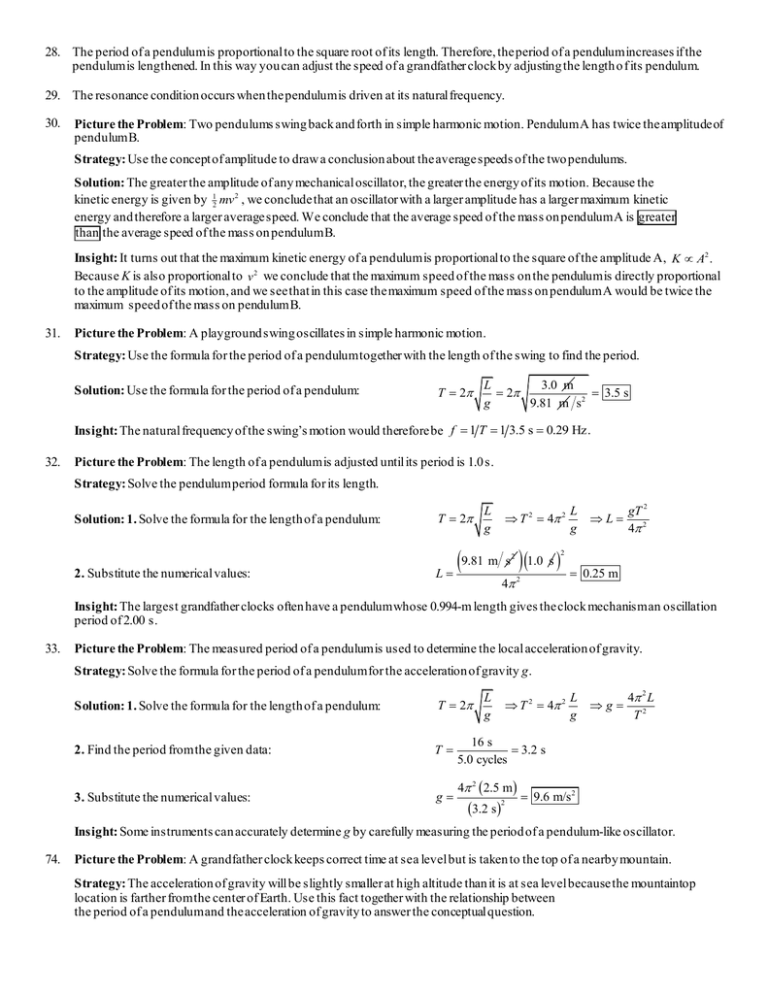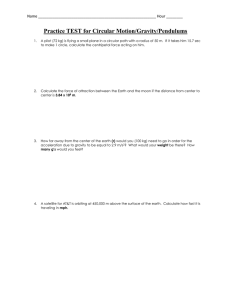28. The period of a pendulum is proportional to the square root of its
advertisement

28. The period of a pendulum is proportional to the square root of its length. Therefore, the period of a pendulum increases if the pendulum is lengthened. In this way you can adjust the speed of a grandfather clock by adjusting the length o f its pendulum. 29. The resonance condition occurs when the pendulum is driven at its natural frequency. 30. Picture the Problem: Two pendulums swing back and forth in simple harmonic motion. Pendulum A has twice the amplitude of pendulum B. Strategy: Use the concept of amplitude to draw a conclusion about the average speeds of the two pendulums. Solution: The greater the amplitude of any mechanical oscillator, the greater the energy of its motion. Because the kinetic energy is given by 12 mv 2 , we conclude that an oscillator with a larger amplitude has a larger maximum kinetic energy and therefore a larger average speed. We conclude that the average speed of the mass on pendulum A is greater than the average speed of the mass on pendulum B. Insight: It turns out that the maximum kinetic energy of a pendulum is proportional to the square of the amplitude A, K A2 . Because K is also proportional to v 2 we conclude that the maximum speed of the mass on the pendulum is directly proportional to the amplitude of its motion, and we see that in this case the maximum speed of the mass on pendulum A would be twice the maximum speed of the mass on pendulum B. 31. Picture the Problem: A playground swing oscillates in simple harmonic motion. Strategy: Use the formula for the period of a pendulum together with the length of the swing to find the period. Solution: Use the formula for the period of a pendulum: T 2 L 3.0 m 2 3.5 s g 9.81 m s 2 Insight: The natural frequency of the swing’s motion would therefore be f 1 T 1 3.5 s 0.29 Hz. 32. Picture the Problem: The length of a pendulum is adjusted until its period is 1.0 s. Strategy: Solve the pendulum period formula for its length. L g Solution: 1. Solve the formula for the length of a pendulum: T 2 T 2 4 2 2. Substitute the numerical values: 9.81 m s 1.0 s L 2 L g L gT 2 4 2 2 4 2 0.25 m Insight: The largest grandfather clocks often have a pendulum whose 0.994-m length gives the clock mechanism an oscillation period of 2.00 s. 33. Picture the Problem: The measured period of a pendulum is used to determine the local acceleration of gravity. Strategy: Solve the formula for the period of a pendulum for the acceleration of gravity g. Solution: 1. Solve the formula for the length of a pendulum: T 2 2. Find the period from the given data: T 3. Substitute the numerical values: g L g T 2 4 2 L g g 4 2 L T2 16 s 3.2 s 5.0 cycles 4 2 2.5 m 3.2 s 2 9.6 m/s 2 Insight: Some instruments can accurately determine g by carefully measuring the period of a pendulum-like oscillator. 74. Picture the Problem: A grandfather clock keeps correct time at sea level but is taken to the top of a nearby mountain. Strategy: The acceleration of gravity will be slightly smaller at high altitude than it is at sea level because the mountaintop location is farther from the center of Earth. Use this fact together with the relationship between the period of a pendulum and the acceleration of gravity to answer the conceptual question. Solution: 1. (a) The period of a pendulum is inversely proportional to the square root of the acceleration of gravity. Decreasing g will therefore increase T. We conclude that if the clock is taken to the top of a nearby mountain the period will increase and the clock will run slow. 2. (b) The best explanation is A. Gravity is weaker at the top of the mountain, leading to a greater period of oscillation. Statement B is partly true but ignores the change in the acceleration of gravity. Statement C could only be true if the mountain were filled with material with a higher than average density, so that the nearby location of extra mass more than compensates for the increased distance from the center of Earth. Insight: Some gravity meters operate on this principle, precisely determining the local acceleration of gravity by accurately measuring the period of a pendulum.
